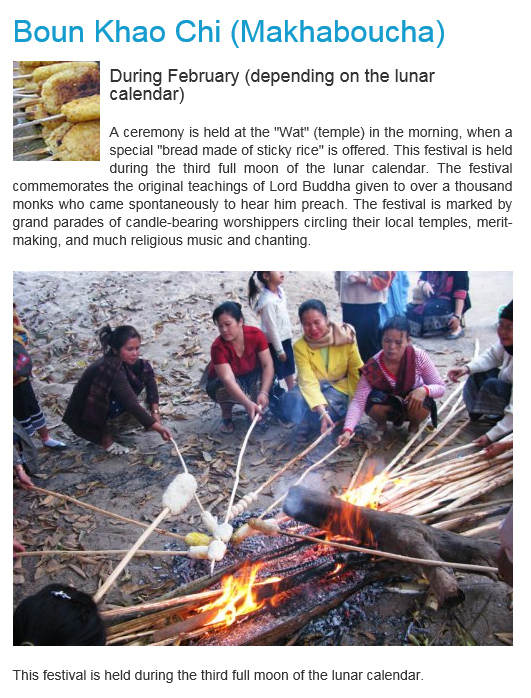

Boun Pi Mi - Lao New Year
Pi Mai Lao or Lao New Year: There are three values associated with the Sangkhan Festival. First, it enhances society by bringing families and community together. Secondly, meritorious acts such as charity work, giving alms to Buddhist monks and releasing animals back into the wild deepens values by showing compassion. In fact, the Lao word for festival is Boun (Pali: Punna), derivative of a Pali word which means merit. By participating in festivals such as the Lao New Year, members of the community partake in the richly Buddhist act of merit-making. Lastly, filial piety, the humble offering of respect and reverence to family, parents, and ancestors is a dynamic element in Lao society, and is highly visible during the New Year celebration. This is done through offering gifts to elders as tokens of gratitude and respect, and in return receiving their blessings. These activities also parallel the cleansing and regeneration symbolized by the arrival of rain.
The Three Days of Pi Mai
Sangkhan Luang: The first day of the New year festival is the last day of the old year. Perfumed water and flowers are prepared for the Lao New Year. In temples (wats) all over the country, Buddha images are taken down from their permanent places and placed within easy reach so villagers can pour perfumed water on them. They then collect the water that runs off the Buddha images and take it home to pour on family members, friends and relatives. This is believed to bless, clean and purify the receivers before entering the Lao New Year.
Sangkhan Nao: The second day of the Lao New Year festival is the "day of no day", a day that falls in neither the old year nor the new year. Houses and villages are cleaned on the second day. Traditionally elders will not allow young people to take naps or lounge aroundl on the second day as it’s believed that if one sleeps or stays still one will get sick in the coming year. Elders encourage young people to clean their places and go out to pour water on other elders in the village and wish them well, and finally get wet themselves. The act of cleaning symbolizes the desire to send bad things away with the old year.
Sangkhan Kheun Pi Mai: The last day of the festival marks the start of the new year. This day many families will hold a Baci or Sou Khuan at their houses to welcome Lao New Year as well as to wish their elders good health and long life. Some might respectfully ask for forgiveness from their elders for things that they did in the past year that might have hurt feelings unintentionally. In the same spirit they give the elders gifts.
In late afternoon or evening of the last day, in the temples, the Buddha images are moved back to their permanent homes. On that same evening devotees go to wats to listen to the monks chant as an act of asking forgiveness from the monks and from the Buddha for any act they might have done in this past few days that might have touched them. In the Buddhist faith monks and Buddha are not to be touched. After that, a vien tien – a candlelight procession – takes place around the wat and that is the end of the Lao New Year celebration.
Pi Mai Traditions
The Myth of King Kablinaphrom
Millenia ago, before the time of Buddha, there was the King deity Thao Kablinaphrom who had four faces and seven daughters. Kablinaphrom, a god like creature, considered himself the wisest in all the world. There was also a creature, lesser than a god but higher in enlightenment than a human who appeared as a boy, Thammaban Kuman, who understood the language of the birds and fashioned himself to be the wisest in the world. Kabinlaphom invited Thammaban to visit and challenged him to answer a three part riddle. If he answered incorrectly he would forfeit his head. On the other hand, if he answered correctly, Kablinaphrom would sacrifice his own head and forfeit his kingdom. The riddle was, 'What part of the human body shines in the morning, in the evening and at nightfall?' Thammaban acceptedthe challenge and asked for seven days to come up with the answer.
After six days Thammaban could not think of the answer to Kabinlaphrom's riddle so he went into the forest to meditate under a large tree. In the tree there were two birds talking to each other. The boy bird asked "What will we eat tomorrow?"
The girl bird replied, "Tomorrow we can eat Thammaban as he will not be able to answer Kabinlaphrom's riddle". She continued by saying, "The answer to the riddle is simple - in the morning you wash your face as you wake up, in the afternoon you wash your body as it gets hot, and in the evening before you go to bed you wash your feet".
Thammaban, knowing the language of the birds and excited that he may keep his life ran back to speak with Kabinlaphrom.
Kablinaphrom was surprised that Thammaban had found the correct answer and agreed to their terms. As he sacrificed his head he warned that if his head ever touched the earth, a catastrophic fire would swallow the world. If it ever touched the sea, the oceans would dry up and if it ever touched the sky, rainfall would cease to exist. Kabinlaphom instructed his seven daughters to place his decapitated head in a cave at the foot of Mount Sumeru, a place neither of this world nor or the world of the gods. To pay homage to their father and to prevent the occurrence of natural disasters, every year, one of the seven daughters attended to the decapitated head by cleansing it and leading a procession around the base of Mount Sumeru to show their reverence to Kabinlaphom. The daughters would visit their father's head every year and perform a ritual to bring happiness and good weather.
Kabinlaphom's Seven Daughters
As the myth tells, Thao Kablinaphrom had seven daughters, one for each day of the week. The day of the week that Lao New Year Day or Sangkhan Kheun Pi Mai falls on determines which of Kablinaphrom's daughters will preside at the festival, ride her chosen animal and carry her chosen weapons in respect of Kablinaphrom and of course, to prevent the catastrophes of which he warned.
Sunday is Thungsa
Her flower is thapthim (peony) which she wears on her ear. Her jewel is the red ruby
and her food is the fig. She holds a throwing disk (chak) in her right hand and a conch shell in her left. She rides Khrut (Garuda) the mythical half man half bird.
Monday is Khorak
Her flower is peap which she wears on her ear and her jewel is the mukda, a cloudy black jewel. Oil is her food. She carries a short sword in her right hand
a cane stick in her left. She rides on a Tiger.
Tuesday is Raksot
Her flower is lotus which she wears on her ear and her jewel is the precious stone mora. Blood is her food. She carries a trident in her right hand
a bow in her left. She rides on a hog.
Wednesday is Mantha
Her flower is champa which she wears on her ear and her jewel is the precious stone phaitoon. Cheese and butter are her foods. She carries a needle in her right hand
a cane stick in her left. She rides on a donkey.
Thursday is Kirini
Her flower is montha which she wears on her ear and her jewel is an emerald. Beans and sesame seeds are her foods. She carries a hook in her right hand
a lyre in her left. She rides on an elephant.
Friday is Kimitha
Her flower is chongkonlani which she wears on her ear and her jewel is the yellow topaz. Banana is her food. She holds a throwing disk (chak) in her right hand and a lyre in her left. She rides on a water buffalo.
Saturday is Mahothon
Her flower is samhaw which she wears on her ear and her jewel is the black sapphire. Her food is venison. She holds a throwing disk (chak) in her right hand and a trident in her left. She rides on a peacock.
Lao Americans re-enact this myth during the New Year festivities each year. At the Wat Lao Buddharam in San Diego, California Boun Pi Mi is a grand celebration on the temple grounds. Sand stupas are erected to symbolize Mount Sumeru, the mountain cave where Kablinaphrom's head was saved and protected. Ceremonies start with Kablinaphrom's daughters taking the head of Kablinaphrom from the cave, washing it, placing it in a pham on the front of the float and then parading it around the temple grounds. On the float, the daughter, chosen by the day of the week, sits atop her animal and her 6 sisters around her. Circling the temple grounds on the float with the temple monks and community members further symbolizes respect for Kablinaphrom and to wish for prosperity and long life and to ward off Kablinaphrom's warnings of disaster. Then Kablinaphrom's head is returned to the cave.
Water is a big part of the New Year celebration symbolizing life and renewal. It is for washing homes, Buddha images, monks, and soaking friends and passers-by. Children first respectfully pour water on their elders, then monks for blessings of long life and peace, and last of all they throw water on each other. The water is often perfumed with flowers or natural perfumes. Some people prefer flowers in the water to give a pleasant smell, as well as adding cologne/perfume. The idea of watering may be related to the myth of the great King Kabinlaphrom whose 4 faces were always hot and in need of cooling.
[top]
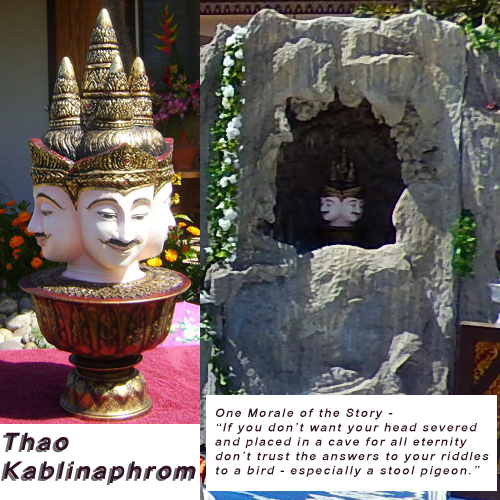
Much of today's Lao New Year festivities and ceremonies are based on the regional traditions of Luang Prabang, Laos where generations of families have embraced and perpetuated the myths of Thao Kablinaphrom and incorporated them into their celebrations.
Sand stupas are erected to symbolize Mount Sumeru and the mountain cave where Kablinaphrom's head was saved and protected. Flags adorn the sand stupa in homage of family and friends with prayers for good health, long life and prosperity.
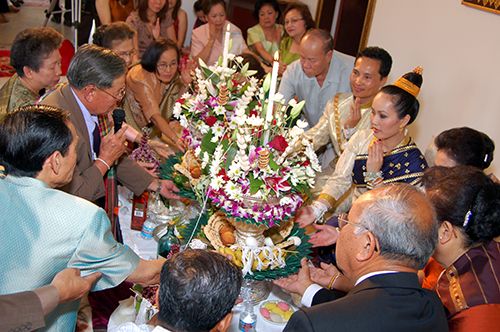
In Lao, “Sou Khuan” which means “spirit enhancing or spirit calling” is their traditional blessing ceremony which has been practiced for hundreds of years. Also called the "Baci or Basi" ceremony, it involves the tying of white cotton strings around a person’s wrists and saying prayers or offering well wishes for whomever the ceremony is intended. The Lao sou khuan ceremony is held for a variety of occasions such as Lao New Year, weddings, births or any time special blessings are desired.
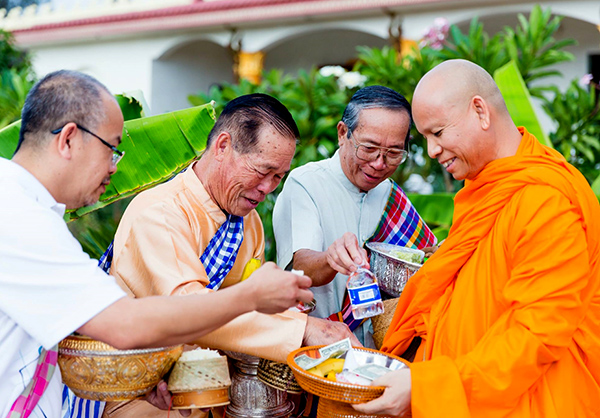
Boun Ork Phansa (Awk or Ok Phansa)
Boun Ork PhansaAlso known as "Thai Loy Krathong"
The legend of Ork Phansa: "Lord Buddha retreated to heaven to visit his mother who died seven days after his birth. After a three months stay, the Lord Buddha returned to earth and was welcomed with great joy and excitement. Gods and goddesses joined in the festivities to welcome him as he descended from heaven on the triple stairway of gold, silver and precious gems, escorted by angels. The people made special offerings of foods, flowers and gifts to celebrate the return of the Lord Buddha".
Today, the Boun Ork Phansa Festival takes place in Laos and all over the world. Buddhists celebrate with joy, food, music and lights the end of the Buddhist Lent (vassa) : during which, for three months of the rainy season, monks stays inside the temple, retreat for meditation, while people refrain from parties, weddings and non religious celebrations. On the last day the monks come out to accept offerings from their people (food, money, etc.) and they share them with the poor, after which they resume their normal social activities. The last night of the Buddhist Lent, Buddhists celebrate Lhai Heua Fai by sending small hand-made boats (krathong) full of lights through the river to celebrate the riches derived from the river and to reflect on their own lives and atone for any misuse of the river.
Lao Boat racing festivals occur around Boun Ork Pansa celebrating the end of the rainy season.

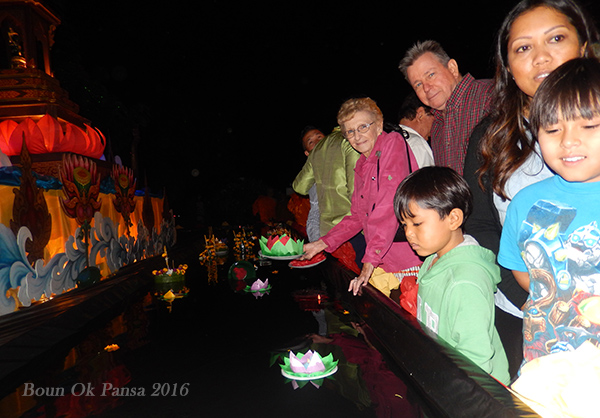
[top]
Boun Phravet
Boun Pavet or Boun Phravet or Boun Phra Vetsandon, is the Lao religious holiday that celebrates the parable of Prince Vessantara, the last pre-incarnation of the Buddha. The parable speaks of absolute charity.
"Once upon a time, in a kingdom called Sivirattha there reigned a king named Sanjaya and his wife Phusati. They lived in a beautiful palace in the city of Jetuttara. In time Phutsadi, standing in a magnificent orchard of sala trees and holding firmly to a branch, gave birth to a beautiful little prince, and they named him Vessantara. Prince Vessantara was born at exactly the same moment as a beautiful white elephant named Peccaya, which had the ability to bring rain.
When Prince Vessantara reached the age of sixteen, he was strong and handsome, and was married to a beautiful Princess named Maddi.
In time they had two children: a son named Jali and a daughter named Kanhajina.
Prince Vessantara wanted to attain perfection, and to do that he knew that he needed to donate all his worldly possessions to others (super karma points). At the retirement of his father Vessantara became king. It wasn't long before eight Brahmins (upper class in the religious hierarchy) appeared from the rival state of Kalinga, which had experienced seven years of drought. They asked to have the white elephant Peccaya so that it could bring them rain instead. And so, seeking to attain perfection, Prince Vessantara gave them the elephant, and the eight Brahmins went away chuckling. Naturally the people of Sivirattha were angry at the loss of their precious and beloved white, rain-bringing elephant, and they petitioned King Sanjaya to return to the throne, and to send Prince Vessantara into religious exile. And so this was done, although not before Prince Vessantara had held a good-bye alms-giving and distributed vast wealth to all who asked. It wasn't long before Prince Vessantara had achieved his goal of absolute charity including giving away everything he held precious including his wife and children.
And god, so moved by the extraordinary acts of charity, restored to Prince Vessantara, all that he had given away including their beloved white elephant Peccaya.
And as promised, upon his death, now King Vessantara was promoted to Lord Buddha".
The festival of Boun Phravet is celebrated by acts of charity between the community and the temple, between families and their ancestors.
IMAGES THAT FOLLOW.
At the Wat Lao Buddharam in San Diego, Boun Phravet includes a temple parade with monks chanting, floats depicting Peccaya the white rain-giving elephant and participants singing and dancing. The baci (blessing) ceremony is stardard fare for most Lao religious events where blessings for prosperity are shared. All around the temple small beds are set up by individual families and upon the beds are placed all manner of things they wish to symbolically give to their ancestors to ensure their comfort like food, clothing, bedding etc. Money trees are common at each bedside and festival participants donate money to the temple through the family trees.
[top]
